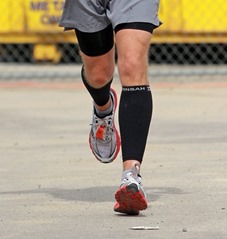 It’s becoming more and more clear based on existing research (and research coming soon) that foot strike patterns in running are influenced by a wide variety of factors. It’s not simply the case that humans use a single foot strike type under all conditions – factors like footwear, surface hardness, speed, and experience all seem to play a role.
It’s becoming more and more clear based on existing research (and research coming soon) that foot strike patterns in running are influenced by a wide variety of factors. It’s not simply the case that humans use a single foot strike type under all conditions – factors like footwear, surface hardness, speed, and experience all seem to play a role.
A new study was just published on-line by Medicine & Science in Sport & Exercise that looks specifically at the influence of speed on foot strike. Previous research has suggested that some runners (not all) migrate foot strike from the heel toward the midfoot/forefoot as they run faster, and this new study provides additional evidence to support this observation. But, it also goes beyond that finding and proposes the identification of a new foot strike type. I find this study quite compelling as it relates to my own running experience and shoe preferences!
Study Abstract:
Relationship between Running Speed and Initial Foot Contact Patterns
Breine, Bastiaan; Malcolm, Philippe; Frederick, Edward C.; De Clercq, Dirk
Abstract
Purpose: This study assessed initial foot contact patterns (IFCP) in a large group of distance runners and the effect of speed on the IFCP.
Methods: We determined the strike index, to classify the runners in IFCP groups, at 4 speeds (3.2, 4.1, 5.1, 6.2 m[BULLET OPERATOR]s-1) by measuring center of pressure (COP) with a 2 m plantar pressure plate. Such a system allows a direct localization of the COP on the plantar footprint and has a low threshold value (2.7 N[middle dot]cm-2) resulting in more accurate COP data at low ground reaction forces than when obtained from force plate.
Results: The IFCP distribution evolves from mostly initial rearfoot contact (IRFC) (82%) at 3.2 m[BULLET OPERATOR]s-1 to more anterior foot contacts with about equal distribution of IRFC (46%) and initial midfoot or forefoot contact (IMFC+IFFC) (54%) at 6.2 m[BULLET OPERATOR]s-1. About 44% of the IRFC runners showed atypical COP patterns with fast anterior displacement of the COP along the lateral shoe margin. Apart from the different COP patterns, these atypical IRFC were also characterized by a significantly higher instantaneous vertical loading rate than the typical IRFC patterns.
Conclusion: The IFCP distribution changes were due to intra-individual alterations in IFCP at higher speeds. That is, 45% of the runners made one or even two ‘transitions’ towards a more anterior IFCP (and 3% shows some other type of transition between initial foot contact styles as speed increases). Although, 52% of the runners remained with the same IFCP.
(C) 2014 American College of Sports Medicine
Methods
The authors recruited 55 runners and had them all wear the same model of cushioned, neutral running shoe (Li Ning Magne). Specs for this shoe were reported as follows for a US size 10: forefoot width 11.2 cm, heel width 9 cm, sole length 31.8 cm, heel thickness 2.9 cm, a heel toe offset of 1.15 cm, and impact testing results following ASTM F-1976-06 procedures of ~950 N or peak g of ~11.5 g. (I wish specs like this were reported for all shoes!)
The authors viewed using a single shoe for all subjects as being a more controlled situation than letting the runners wear their own shoes. I agree to an extent, but I do worry a bit about studies that put runners in novel footwear without allowing enough acclimation time (only a 5-10 warmup in the new shoe completed here). The authors acknowledge this possible limitation and they report that an initial “questionnaire did not indicate a systematic difference in habitual shoe type between different IFCP (initial foot contact pattern) groups.”
Each runner ran along a 25 m trackway at 4 speeds: 3.2 m/s (8:22/mile), 4.1 m/s (6:32/mile), 5.1 m/s (5:15/mile), 6.2 m/s (4:19/mile). The trackway was fitted with a force plate mounted with a pressure plate on top. This is a unique approach in that the added pressure plate is more sensitive at detecting smaller forces associated with initial contact and thus is more accurate at defining initial contact location.
The authors defined foot strike using the Strike Index (SI), which divides the foot into thirds from heel to toe. This is a standard method to classify foot strike in the lab, but I do agree with Daniel Lieberman who described his concerns about the ability to accurately classify forefoot strikes using SI:
“…strike index…uses the center of pressure at landing relative to maximum shoe length, with a RFS being less than 33%, a MFS between 34% and 66%, and a FFS as 67% or higher (4). This index, however, is arbitrary with respect to the foot’s anatomy. My observation is that the 4th and 5th metatarsal heads are often less than 67% of the foot’s length, leading one to classify FFS and MFS landings in the same category.”
Results
Foot strike patterns for the left foot at each speed were classified as follows:
| Initial Contact | 3.2 m/s (8:22/mile) | 4.1 m/s (6:32/mile) | 5.1 m/s (5:15/mile) | 6.2 m/s (4:19/mile) |
| Heel | 45 | 43 | 36 | 29 |
| Midfoot | 10 | 10 | 16 | 11 |
| Forefoot | 0 | 2 | 3 | 15 |
Foot strike patterns for the right foot at each speed were classified as follows:
| Initial Contact | 3.2 m/s (8:22/mile) | 4.1 m/s (6:32/mile) | 5.1 m/s (5:15/mile) | 6.2 m/s (4:19/mile) |
| Heel | 45 | 43 | 34 | 22 |
| Midfoot | 10 | 9 | 16 | 24 |
| Forefoot | 0 | 3 | 5 | 9 |
These results agree with expectations based on previous research in that some, but not all, of the runners shifted from a rearfoot strike to a mid or forefoot strike with increasing speed (variation once again!). The left-right asymmetry at the fastest speed is curious, not sure what to make of that. In my own Manchester marathon foot strike study I did find that “..asymmetrical runners tended to heel strike more often on the left side, forefoot or midfoot strike on the right side.” But, that was at a considerably slower pace than 6.2 m/s.
The authors also performed statistical analyses (a three-level linear regression for you stats folks) to test for a relationship between speed and strike index within individuals. They found a significant effect of speed on strike index (faster speed = increased strike index = contact further forward on the foot), with only 3.2m/s and 4.1m/s not being significantly different. This basically means that at the two slower speeds strike index remained pretty consistent, but once pace dropped to 5:15/mile initial contact moved forward on the foot, and then moved even further forward at the fastest speed.
One fascinating thing about the results is that the authors identified a group they referred to as transition runners. 37% of subjects shifted foot strike type once at a faster speed (mostly heel to midfoot), and a second group shifted twice as speed increased (heel—>midfoot—>forefoot). In contrast, 46% were heel strikers at all speeds, and 6% were midfoot strikers at all speeds. Again, there is variation among individuals in the way they alter stride with increasing speed. The authors point out that “These ‘transitional’ runners create the complex task of a shoe design that, both at low and high running speeds, is functionally adjusted for changes in IFCP.” Or, simply, that such gear shifting runners might be best served by choosing different shoes depending on the type of workout they plan to do.
One other fascinating result is that they found two subgroups of rearfoot strikers that could be distinguished based on the underfoot pressure patterns. One group (72% of rearfoot contacts) had “…a COP trajectory with the initial contact at the posterior lateral shoe sole side, after which the COP moves rapidly towards the midline of the shoe sole.” The pressure then moves forward and takes a bit longer to reach the forefoot. You might think of this as the typical heel-forefoot roll seen in many runners (I might call it a classic heel striking pattern).
In the other group (28% of rearfoot contacts), “initial contact was made in the rearfoot zone, immediately followed by a fast anterior COP movement along the lateral shoe margin into the midfoot zone, which was then followed by the COP moving medially in the midfoot zone.” The atypical heel striking group shifts pressure to the region under the metatarsals of the foot much faster than the typical heel strike.
The authors go so far as to propose founding “…the identification of the atypical IRFC as a distinct fourth IFCP” (forefoot, midfoot, and the two types of heel strike). Doing so would emphasize that all heel strikes are not the same, and perhaps more interestingly, might call into question studies that have lumped all heel strikers into a single group for comparative purposes. As a first step, the authors present data showing that contact time was longer in the typical rearfoot striking group than in all other foot strike classes (including atypical rearfoot strike), and that the atypical rearfoot strike group exhibited the highest vertical impact loading rate of any of the classes.
Conclusions
I’d summarize the primary conclusions of this paper as follows:
1. Increasing running speed shifts the contact point on the foot forward. In some people this shift is significant enough that a change in discrete contact pattern is observed (e.g., heel to midfoot). Sometimes two discrete contact pattern shifts occur (heel—>midfoot—>forefoot). In some people there is no change in discrete contact pattern (e.g., they land on the heel at all speeds, but maybe slightly further forward on the heel when running faster). There is no single pattern applicable to all runners .
2. There are two types of heel strikers. One exhibits a slower heel-forefoot transition, which the authors term the “typical” heel strike. Overall contact time is longer in this group, but in a shoe with a cushioned heel the vertical loading rate is the same as in a midfoot or forefoot striker. The “atypical” heel strikers contact on the heel but pressure moves rapidly to the forefoot. Contact times is shorter than in a typical heel striker, but vertical loading rate is higher than in any of the other categories.
I’ll finish with some thoughts relating to the second conclusion.
I suspect strongly that my stride fits within this newly proposed atypical heel strike category, and further that this may be why I am very sensitive to firmness and amount of flare of the lateral portion of the sole of running shoes. Most of my shoe wear is a bit forward from the posterolateral corner of the heel (I used to chew that area up, not anymore), but not on the midfoot or forefoot (except maybe in very minimally cushioned shoes). Having run on a force-plate equipped treadmill I’ve been told my SI is a midfoot strike, but this did not utilize the more sensitive pressure pad method used here.
This study found that vertical loading rate was highest in the atypical heel strike group (to which I think I may belong). About this the authors write the following (my comments in parentheses):
- “When running with an IFFC or IMFC the impact of running is partially attenuated by an initial ankle dorsiflexion movement.” (i.e., the ankle + calf muscles are involved and reduce loading rate)
- “With a typical IRFC this is done by the cushioning properties of both the heel’s fat pad and shoe midsole.” (i.e., a cushioned heel reduces loading rate)
- “A possible explanation for the higher VILR associated with an atypical IRFC could be that when running with an atypical IRFC neither of these ‘strategies’ of impact reduction are fully used. Initial contact is made with the rearfoot, limiting the possible use of an ‘ankle-dorsiflexion strategy’ and the early first metatarsal contact and the fast anterior COP movement indicates the limited use of the cushioning properties of the heel partition.”
This is brilliant. Most shoes are designed to cushion a typical rearfoot strike starting near the back of the shoe. A forefoot striker relies less on cushion and more on the calf muscles to slow the landing. An atypical contact can’t make use of either of these strategies if the shoe is not designed for it.
I find that shoes with a soft heel and firm forefoot work best for me. A shoe with an overly firm or rigid heel does not work well for me at all – I might describe the ride on pavement as jarring. Examples of shoes like this include the Mizuno Sayonara and Saucony Ride 7. I can make such shoes feel comfortable by forcing a more pronounced heel strike or by getting up on my forefoot, but that requires conscious effort. I would be very interested to compare my vertical load rate in a shoe like the Sayonara to a shoe like the New Balance 1400v2 or Newton Energy. I’m really curious if identifying these heel strike patterns could lead to better shoe recommendations for runners, and might explain why a shoe that works well for one heel striker might not work well for another.
As always, lots of additional work needs to be done!
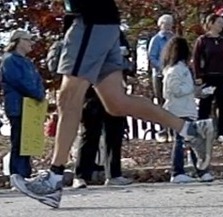
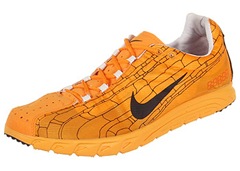
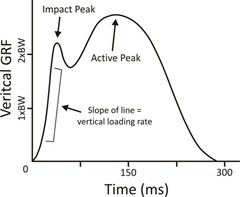
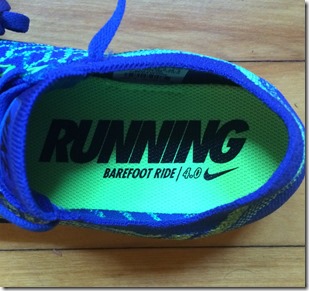














I think the left-right assymetry might be explained by the fact that there are more righties than lefties, and therefore for these runners, they also have a dominant right leg compared to left leg. I know that’s true for me. Given this, you’d expect that more pushing off is done with the dominant foot, especially at faster speeds, and you can’t push off on the heel so you’d prefer to land on your forefoot for a shorter/faster transition to the push off.
the theory about handedness is possible, but there’s another possible explanation.
in the bike fitting world, there is a tendency for riders to “protect” the right leg. that is, they unconsciously sacrifice the left leg to keep the right ilium secured on the saddle and the right leg moving in a perfect circle.
the left leg is forced through an imperfect circle and a host of problems results…ITB, knee pain, calf pain, back pain, etc.
this happens equally to lefties and righies. no difference.
steve hogg writes about this a lot on his blog. he’s probably the leading bike fit expert in the world.
link to stevehoggbikefitting.com
Eric- Thanks for putting in that insight from the cycling world. My first thought was the same as Andy’s, that the discrepancy had to do with which side is dominant. Has Steve offered up any reasons for why riders might tend to protect the right side, irrespective of “handedness”? Or do you have any ideas?
I’ve always been curious about whether working a gas pedal with the same foot every time we drive might have some influence, particularly for those who commute to work every day. Lots of work for one lower leg and not the other.
this theory makes a ton of sense. When I was still doing PT we would see a ton of R sided injuries from driving: piriformis, calf, heel pain, etc…
We see the same thing with clients in our Feldenkrais/running form practice. My way of describing it is that the left leg is the stability (or standing) leg and the right leg is the mobility (or gesture) leg. The right foot is much more likely to be turned slightly out and the right side of the torso is more likely to be muscularly shortened from hip to shoulder. The glutes are likely to work better on the right. I’d always assumed it was due to driving but I started checking with my clients and many of them (in NYC) didn’t drive, so that’s not it. I recently discussed it with a podiatrist and she said she and her colleagues noticed it too, it’s a bit of a mystery. The only reasonable hint I’ve come across is that it may be related to the liver — the heaviest organ — being on the right side, and therefore having to be shifted to the left slightly through a contraction of the right obliques (stand up and try it and you’ll see what I mean). Doing this with your trunk will make the left leg your stability leg, bias you towards the heel in running, and put you more on your forefoot on the right. Chek practitioner friends of mine have noticed this asymmetry improves when people remove the most common allergens from the diet, which points again at the liver, and a stressed liver being perhaps larger or heavier or having some other effect on movement. All speculation, but at the very least it does show that this pattern has been widely observed!
Interesting stuff. The second type of rearfoot landing (quick transfer) the authors note reminds me of this passage from Lydiard’s “Run to the Top (1962), p. 34:
“Don’t run on your toes unless you want to work your calf muscles unnaturally, …. It is better to come down with a nearly flat foot, with the heel hitting first…. In the half-mile or under, of course, it stands to reason that you will run on your toes, as the sprinter does naturally when he throws his body forward and stretches out his stride.”
Old school.
This question is not specific to this study, but is there a standard definition of the midfoot strike that all researchers use? From what I’ve read, and discussions I’ve had with people doing research, there does not seem to be one. If there is, could you point me to it? Also, one other point, the atypical heel strike is not really new. I’ve seen it described before by the material produce about BK running technique, as well as other various articles.
Depends on which classification scheme is used. Strike index is pretty standard in force studies, for video simultaneous contact of the heel and ball of foot is the typical definition. What’s new with the atypical heel strike I think is the ability to describe exactly how it differs using pressure patterns under the foot.
I would suggest maybe the opposite, at least in my case. I’m a righty, but jump, push off for a baseball throw, and in general have better balance on my left foot. Most of my shoes show significantly more wear on the left foot. Interesting read, thanks for the article.
I still don’t see how anyone can definitively label themselves as one type of footstriker. The way your foot impacts the ground while running will change depending on your footwear (or lack thereof). I ran in some Altra Adams today and a new pair of huarache-type sandals, and it’s very hard to have a heel strike in a shoe like this. At least for me, my knees and ankles (I think) are naturally more bent to absorb shock, my cadence stays high, and my foot lands flat.
I know it’s not cool right now to still be talking about minimalism, but there is something to it.
Will running in a very minimal shoe change foot strike? In some people yes, in others no if we are talking about say a discrete change from heel to mid/forefoot. Some interesting studies on this coming later this year.
Interesting study, but alas falls short on the footwear side. It would have been great to test the same subjects with a set of different shoes with different heel drops, rather than just one with big heel drop. My guess is that we’d see a migration of the numbers of runners in each of the classifications. Shoe stiffness would also be a factor.
Peter, your observations about shoe preference, soft heel/firm forefoot, and exaggerating heel strike, suggests to me an issue of force vs pressure.
The force, at any instant, being applied by the body through the shoe to the ground is equal to the instantaneous pressure x contact area. If we apply the force over a small area of the heel via an exaggeration dorsaflexion of the ankle we may be reducing the area of contact and as the pressure sole can push back with is governed by how much it’s compressed it’ll have a similar pressure profile as it compresses, but the force generated will be less. This means it’ll take longer to the force to peak. The shoe will feel to the runner less stiff.
If you land more flat footed then you rapidly distribute the loading across the a wider area, the compression of the sole will be less, and less localised pressure, but the overall force can be greater. The amount of compression of the sole will also be less, and the runner will perceive the shoe as being more stiff.
This is all with the same shoe, just a slightly different foot-strike.
A runner that lands with the ankle rolled so the outside edge of the foot will like reduce the contact area and like the exaggerated heel strike case in effect make result in a lower effective stiffness of the shoe.
For myself, my default landing is a mid-foot one, going uphill or sprinting it’s often a pure forefoot, when descending it’ll vary between forefoot, mid-foot and heel strike. I also have a preference for firm zero drop soles.
For a bit of variation in my shoe rotation I recently bought a pair of Nike Kiger’s, they are soft in the forefoot and even softer in the heel. Initially I really disliked the feel of softness of the sole and found it quite unstable, but now with 60 miles in them I’ve tuned into them more and am less put off. It also took me quite a few miles to recondition my leg muscles to handle the instability of the soft sole.
One thing I don’t notice is the soft heel though, I believe because I’m still running with a mid-foot strike so by the time my heel touches down I’m spreading my weight over a large area so the effective stiffness is higher. If I deliberately heel strike it feels mushy and unstable, yuk!
Going back to my F-Lite 232’s on my new X-Treme 178’s the soles feel firm, but after a half a mile I dial in and they disappear on my feet. I don’t know how much this is down to me adjusting my gait sub-consciously or my brain just dialling into what pressure patterns are normal, safe and don’t require any conscious intervention.
Great research link, but I must point out one of my HUGE pet peeves with this study:
“Each runner ran along a 25 m trackway at 4 speeds”
WHAT?!?! Find me any runner that gets into their natural stride in 25 meters and I’ll give you 10 dollars. Especially at faster speeds, I believe that most people would still be accelerating, finding their rhythm, and/or starting to slow down since the wall is coming at them quickly!
I have been a proponent that speed and surface change run stride mechanics, and we have data to back this up. But this study has some major limitations when applying the data to “real world” running.
I agree, I always worry a bit about trackway studies. Major limitation, as well as force plate targeting. Tough to avoid that as much as you might try I think.
What a Great Post, Being a engineer and a coach, checking out biomechanics is what i like the most, eventought i do not usually play around with the runner mechanics, unless i find it useful, i mostly use it to check on general running mistakes for beginners and to find out weak muscle areas or lack of balance between muscle groups. i have been asking myself for quite a long time about the right-left asymmetries, which i bond to usually muscle weakness or compensation for injuries, for example i usually found that a leg that heelstrike the most is associated in what i have seen with hip shifting on the midstance on that side because of gluteus medius weakness or so (i do not know why it happen , just pointing out). other cases i found out a leg that midstrike most to be people usually recreational who had previous anterior shin splint injuries or knee issues and found a self compensation mechanics by mid-striking on that leg.
About the changing strike patterns depending on the speed is something that i usually see and also had me wondering. My conclusion also was tied to runner muscles balance and ROM. more advance runners who have very good hip extension, strong core and so, usually change more the gait from mildly heel or mid striking on easy or marathon pace, to fully forefoot on 5k pace or faster. while i found that recreational runners that have limited ROM on the hip, or hamstring, weak core, etc, will tend to keep on heelstriking no matter the speed. Of course these are things i have noticed not in all advance or recreational, but i have noticed to be trendy.
i share these experiences in bases to found common point of view, these post its been great.